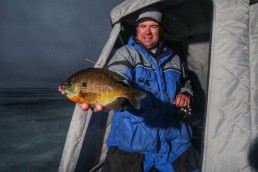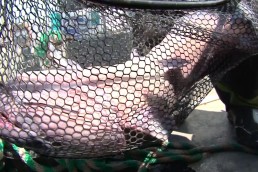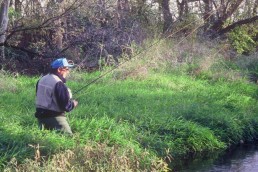Picking Apart Schools of Fish in Wintering Holes
SHARE THIS POST
It’s no secret that so many fish we like to target through the ice will eventually slide out and winter over the holes and basins. These spots will typically load up with fish each winter. While you might be targeting crappies or bluegills, you might encounter channel catfish, drum, white bass or tullibees, depending on the fishery.
What fascinates me when I drop an underwater camera down into these clouds of fish is how often different species school together. Very seldom are these fish static, just hanging in one spot. Often, they seem to be simply swimming in circles and I have watched waves of fish come through that were made up of several species. It’s also common for crappies, largemouths and sunfish to swim and school together. I’ve also seen walleyes, white bass, drum and catfish swim around together.
Reservoirs can often be the most challenging to correctly identify what you are fishing because they have such a wide variety of biomass. Reservoirs typically host the native river fish along with several other species that were suited after the river was dammed to form the current reservoir.
Every body of water will have specific tendencies that need to be deciphered by spending time on the water. On some lakes for example, the crappies tend to ride on the top of the school. Other bodies of water see the large panfish on the bottom of the school or in the front of the school. These patterns can sometimes change from day to day, but each body of water will have its own patterns or traits. Figuring out the dynamics of these suspending schools of fish can be challenging, though crucial for maximizing your catch.
This is a situation where underwater cameras shine.
Analyzing the dynamics of a school of fish can be done precisely with a camera, assuming you have enough light and good water clarity. This visual image can help immensely and gives you that inside knowledge and understanding of the water, which can then be applied to your sonar. Ninety percent of the time, I pick a Vexilar flasher over an underwater camera because of the speed factor. I can fish so much more water with one, but a camera can aid sonar by answering questions. Vexilar’s Scout Camera is a rugged and durable camera unit that truly complements the flasher lineup too, so it is popular with ice anglers.
Are you enjoying this post?
You can be among the first to get the latest info on where to go, what to use and how to use it!
Some of those questions answered quickly by a camera might be a visual picture of the bottom or the type of weeds present. But where a camera can really outperform sonar is when determining the species. When you are marking all kinds of fish, different species will all make the same red marks on a flasher. A camera can let you know what the red marks are. Taking camera use a step further, you can get an understanding of how the fish are schooling so you can adapt your fishing strategy. If crappies are indeed on the top of the school, you now know to fish above the fish and separate the crappies by fishing high. If the big bluegills or other targeted species are in the bottom, you now know to fish down fast through them so you can reach what you’re are after without getting bit on the way down.
So often when I use a camera for studying the dynamics of a cloud of suspended fish, I don’t use the camera to find my lure and fish—all I want is the visual. Once I have that mental picture of how the fish are moving and relating to each other I’ll put the camera away and use the flasher so I can fish faster. While nothing beats a camera for ID, you can lean on the flasher to help you sort through unintended species to reach the fish you are ultimately after.
As a rule of thumb, panfish don’t typically dart in and out of the cone angle, slashing at your bait. Something else you can do to test a fish is seeing if the target will chase down hard after a bait. Tullibees, for example, will often burn down at a fast rate when you drop the bait. Crappies typically stall and won’t follow bait down, and if they do chase, they are noticeably slow.
Finding these small nuances and getting a more intimate understanding of the water you are fishing can allow you to sort through rough fish better, or in some cases, target the larger fish. When targeting panfish over wintering holes this season, remember that panfish are not the only species using these locations. One of the most effective strategies for picking apart this water is by using the one-two punch of an underwater camera and flasher.
Jason Mitchell is a top walleye guide on Devils Lake, N.D. He is the host for the outdoor program, “Jason Mitchell Outdoors.” Visit jasonmitchelloutdoors.com for more.
MWO
SHARE THIS POST
Did you enjoy this post?
You can be among the first to get the latest info on where to go, what to use and how to use it!
Jason Mitchell
Jason Mitchell was a top walleye guide on Devils Lake, N.D. for nearly 20 years. Today, Mitchell produces the Jason Mitchell Outdoors TV program. Visit jasonmitchelloutdoors.com for more.



